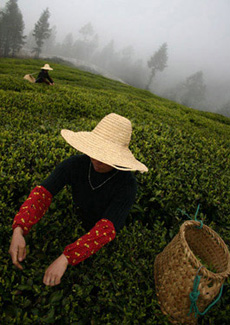
 Harvesting white tea. Photo courtesy of Rishi Tea. Harvesting white tea. Photo courtesy of Rishi Tea.
August 2005
Updated January 2009
|
 |
Information About Tea: Essential Tea Facts
A Cupful About One of the World’s Most Popular Beverages
CAPSULE REPORT: About half of the American population drinks tea, although surprisingly, most of it, 85%, is iced and in bottles. In 2006, Americans drank more than 2.25 billion gallons of tea, 83% black and 16% green. While tea is the second most-drunk beverage in the world after water, it’s number 5 in the U.S., though growing thanks to research indicating what the Chinese have espoused for 5,000 years: It’s a “health drink.” This article has a wide range of facts sure to please tea lovers. This is Page 1 of a 4-page article. Click the black links below to view the other pages.
Black Tea vs. Green Tea vs. White Tea
All tea comes from the Camellia sinensis plant: it is the processing after plucking that determines which of four categories the tea falls into:
- Black tea is substantially oxidized in a process that takes from two weeks to one month. Black tea is further classified as either made in the orthodox method or CTC (Crush, Tear, Curl), a production method developed about 1932. Unblended black teas are also identified by the estate they come from, their year and the flush (first, second or autumn). Orthodox and CTC teas are further graded according to the post-production leaf quality by the Orange Pekoe system, a size grading.
- Oolong oxidation is two to three days—somewhere between the standards for green tea and black tea.
- Green tea is oxidized very briefly by application of heat—either with steam, a traditional Japanese method; or by drying on hot pans, the traditional Chinese method. The tea is processed within one to two days of harvesting.
- White tea undergoes no oxidation.
Most Teas are Blends
Most loose teas and almost all teas in teabags are blends. Because tea from the same estate will taste different in different harvests, the aim of blending is to ensure a consistent taste from season to season so the customer can rely on the product. Blending is also done for price purposes: more expensive, tastier tea may cover the inferior taste of cheaper tea. Examples of blends include:
- Breakfast tea: Generally a blend of different black teas that are robust and full-bodied, and go well with milk. Well-known blends are English Breakfast and Irish Breakfast. Afternoon blends are lighter. Both blends are popular in the British Isles.
- Jasmine tea: Jasmine flowers are spread on the leaves while oxidizing, and in some blends are are left in the tea as a decoration. Many other flowers, including roses and other fragrant blooms, are used as flavorings.
- Earl Grey tea: A mix of black teas, flavored and scented with essence of the bergamot orange.
- Spiced tea: The most famous is Indian chai, flavored with sweet spices such as ginger, cardamom, cinnamon, black pepper, and clove. Indian bay leaf and sometimes nutmeg are common in southern Asia and the Middle East.
- Touareg tea: A strong green tea made with nana mint, prepared in desert areas of North Africa and the Middle East.
- Jagertee: A tea infused with rum.
- Gen Mai Cha (genmaicha): A Japanese green tea mixed with toasted rice.
Continue To Page 2: The Word “Tea”
Return To Article Index At The Top Of The Page
© Lifestyle Direct, Inc. 2005-. All rights reserved. Images are the copyright of their respective owners.

|